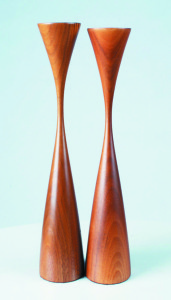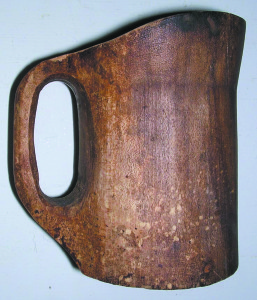Whether you call it treen or woodenware, turned wood objects have come a long way from their functional, humble beginnings. Over the centuries they have evolved into a variety of decorative forms. Many are now displayed in museum collections.
Before Americans set their tables with pottery, porcelain and pewter, there were plates, bowls and mugs made from turned wood or from a jackknife. In fact, common folk Europeans were using woodenware until the 16th century when pewter came into use.
Up until the American Revolution, most Colonists in remote areas were still eating from wooden plates and bowls. They were turned on a lathe and are known as turned wood.
The appearance of many serving items was different from those we use today. Plates were sometimes as shallow as trays or a cross between a tray and a bowl. They also had a variety of names. “Noggins” look like mugs. A “trencher” took many forms and was used for serving food to being a dough bowl.
By the early 19th century the Pennsylvania Germans used decorative carving on such humble items as rolling pins as well as butter molds and cookie boards. Popular woods were walnut, maple and oak.
 One of the first people in the 20th century to envision wood as decorative as well as functional was Russel Wright(1904-1976). In the 1930s he created “Oceana” a line of bowls in biomorphic shapes, popular in mid-century modern era.
One of the first people in the 20th century to envision wood as decorative as well as functional was Russel Wright(1904-1976). In the 1930s he created “Oceana” a line of bowls in biomorphic shapes, popular in mid-century modern era.
In America, the idea of wood turning as an art form didn’t catch on till the late 1940s with exhibits of lathe-turned wood bowls by James Prestini (1908-1993.) He used straight grained woods to create bowls as thin as porcelain.
Another pioneer in the field is master wood carver, Rude Osolnik (1915-2001) known for his signature candlesticks and bowls.
However, it wasn’t till the 1970s and the Bicentennial that 20th century professionally turned wood objects began to be seriously collected.
CLUES: Examples can be seen in museums round the world. Discover tomorrow’s wood masters at craft shows. Be wary of so-called antique wooden ware since reproductions were made during the Bicentennial.
PHOTO CAPTION: (1) Antique wood noggin. PHOTO CREDIT; (1) EBAY
PHOTO CAPTION: Turned wood, walnut candlesticks, Rude Osolnik PHOTO CREDIT: Boston Museum of Art
PHOTO CREDIT: Boston Museum of Art
















Follow Us